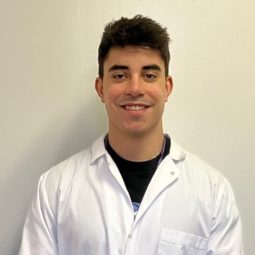Research

Research Scientist, Center for Dementia Research
Efrat.Levy@nki.rfmh.org
Professor,
Departments of Psychiatry, Biochemistry, and Molecular Pharmacology
NYU Grossman School of Medicine
Levy NYU Page
Efrat.Levy@nyulangone.org
Levy Lab
Vesicular trafficking in the brain during aging and in Alzheimer’s Disease
A major focus of research in the laboratory has been to identify the factors that initiate and propagate pathology in neurodegenerative disorders. Using multidisciplinary approaches, we have been studying cell biological processes that can be modified to protect neurons and the brain during aging and from neurodegenerative diseases.
In recent years we have been studying vesicular trafficking, foundational studies that have allowed us to develop the models and methods to examine the role of extracellular vesicles as either protective or pathogenic vehicles within the brain. The elimination of cytotoxic material from the cell via extracellular vesicles, including exosomes and microvesicles, can spread toxic material in the central nervous system, promoting the development of neurodegenerative diseases such as Alzheimer’s disease (AD). AD is a chronic neurodegenerative disorder, one of the leading causes of death among the elderly. A central pathological feature of the disease is the accumulation of amyloid β in the brain and extensive evidence suggests that amyloid β has an important role in the disease process, leading to the brain dysfunction characterizing patients. We found that human and mouse brain extracellular vesicles are enriched with the carboxyl-terminal fragments of the amyloid β precursor protein (APP), neurotoxic proteins that are a source of amyloid β, suggesting a pathogenic role in propagation of amyloid β-pathology throughout the brain.
Our findings also suggest that the secretion of extracellular vesicles is a mechanism for the clearance of endocytic vesicular content when disease-mediated dysfunctions in the endosomal-lysosomal pathway prevent the efficient transport of cargo for degradation in the lysosomes. Ongoing studies are investigating the effects of endosomal-lysosomal and autophagic abnormalities on extracellular vesicles secretion and both the protective and pathogenic function/s of brain extracellular vesicles. We are also studying the apolipoprotein E (APOE) genotype, an important determinant of an individual’s risk for developing AD. While the APOE2 allele appears to be protective, APOE4 increases the risk for the disease as compared with carriers of the neutral-risk APOE3 allele. Additionally, APOE4 expression can lead to cognitive decline during aging that is independent of characteristic AD pathology. Our data show neuronal abnormality in the brain of APOE4 carriers and lower levels of extracellular vesicles released into the brain extracellular space. Compromised vesicle production is likely to have adverse effects, diminishing a cell’s ability to eliminate accumulated toxic material, leading to neuron vulnerability in APOE4-expressing individuals. Extracellular vesicular dysfunction is a previously unappreciated component of the brain pathologies that occur as a result of APOE4 expression, contributing to higher risk of developing AD. Moreover, we found that in brain, APOE2 drives higher exosome number with age when compared with APOE3 mice. We are currently investigating the changes in the brain of carriers of APOE4 allele as compared with the APOE2 allele to identify therapeutic targets based on the differences in release and content of extracellular vesicles due to the different APOE genotypes.
Additional neuroprotective function of extracellular vesicles depends on their content of protective proteins in the brain extracellular space and through their uptake by brain cells. We have been studying the neuroprotection activities of cystatin C. We demonstrated that cystatin C alleviates endosomal-lysosomal abnormalities and memory deficits in mouse models of Down syndrome and of progressive myoclonus epilepsy, and our current studies have shown that cystatin C enhances secretion of extracellular vesicles – suggesting a mechanism by which cystatin C can be neuroprotective in neurodegenerative disorders with endosomal and/or extracellular vesicles disruption. Furthermore, these studies utilize extracellular vesicles as protective vehicles. Extracellular vesicles transport their content for long distances through the extracellular space and into recipient cells and would deliver the protective proteins, providing a novel therapeutic approach for AD.
In order to investigate the interrelationship between pathology in the endosomal-lysosomal pathway and release of extracellular vesicles, we developed a method for the isolation of extracellular vesicles from brain tissue, a method we initially published in 2012. We further modified this method, contributing to the identification of a novel type of mitochondria-derived extracellular vesicles that we termed mitovesicles. Mitochondrial dysfunction is an established hallmark of aging and neurodegenerative disorders. We found that the levels and cargo of mitovesicles increase during pathophysiological processes where mitochondrial dysfunction occurs, including in the brain of Down syndrome individuals, AD patients, and during aging. We are currently investigating the protective role of all types of extracellular vesicles in the brain, as well as their contribution to the propagation of disease throughout the brain. Our translational research also involves the delivery of proteins and peptides that prevent the development of AD via extracellular vesicles.
Research Interests
Dr. Levy is interested in the cellular and biochemical events that lead to Alzheimer’s disease (AD) and other neurodegenerative disorders. These studies include the identification of mutations in familial forms of amyloidoses and the effect of the resultant amino acid substitution on amyloidogenesis; identification of factors that affect the generation of amyloid proteins, that inhibit either the metabolism of the precursor protein or the tendency of the protein to aggregate into oligomeric and/or fibrillar forms; and study of neuroprotective proteins and the mechanisms of neuroprotection. These studies identify treatment targets for AD and other neurodegenerative disorders.
Education
M.Sc. (Endocrinology), School of Biological Sciences, The Hebrew University, Jerusalem, Israel
Ph.D. (Cell Biology), School of Biological Sciences, The Hebrew University, Jerusalem, Israel
Postdoctoral Training
Department of Biochemistry, New York University Medical Center, with Dr. Nicholas J. Cowan
Academic Appointments
Teaching Assistant, The Hebrew University, Jerusalem, Israel
Instructor, The Hebrew University, Jerusalem, Israel
Assistant Research Scientist in Molecular Biology, with Dr. Blas Frangione, Department of Pathology, New York University School of Medicine, New York, NY
Assistant Professor, Departments of Pharmacology and Pathology, New York University School of Medicine, New York, NY
Associate Professor, Departments of Psychiatry and Pharmacology, New York University School of Medicine, New York, NY
Professor, Departments of Psychiatry and of Biochemistry and Molecular Pharmacology, and the Neuroscience Institute, New York University Grossman School of Medicine, New York, NY
Selected Publications
D’Acunzo P, Kim Y, Ungania JM, Pérez-González R, Goulbourne CN, Levy E. Isolation of mitochondria-derived mitovesicles and subpopulations of microvesicles and exosomes from brain tissues. Nat Protoc. 2022 Nov;17(11):2517-2549. doi: 10.1038/s41596-022-00719-1. Epub 2022 Aug 12. PMID: 35962195; PMCID: PMC9633367. Full text
D’Acunzo P, Pérez-González R, Kim Y, Hargash T, Miller C, Alldred MJ, Erdjument-Bromage H, Penikalapati SC, Pawlik M, Saito M, Saito M, Ginsberg SD, Neubert TA, Goulbourne CN, Levy E. Mitovesicles are a novel population of extracellular vesicles of mitochondrial origin altered in Down syndrome. Sci Adv. 2021 Feb 12;7(7):eabe5085. doi: 10.1126/sciadv.abe5085. PMID: 33579698; PMCID: PMC7880603. Full text
Perez-Gonzalez R, Gauthier SA, Kumar A, Levy E. The exosome secretory pathway transports amyloid precursor protein carboxyl-terminal fragments from the cell into the brain extracellular space. J Biol Chem. 2012 Dec 14;287(51):43108-15. doi: 10.1074/jbc.M112.404467. Epub 2012 Nov 5. PMID: 23129776; PMCID: PMC3522305. Full text







